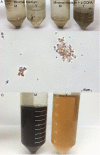Evaluation of melanin production by Sporothrix luriei
- PMID: 29211110
- PMCID: PMC5719544
- DOI: 10.1590/0074-02760170339
Evaluation of melanin production by Sporothrix luriei
Abstract
There is a paucity of studies on the cell biology of Sporothrix luriei, the less common of the pathogenic Sporothrix species worldwide. The production of DHN-melanin, eumelanin, and pyomelanin were evaluated on the mycelial and yeast forms of the S. luriei ATCC 18616 strain. The mycelial form of this species produced only pyomelanin, which protected the fungus against environmental stressors such as ultraviolet light, heat, and cold. The yeast form was unable to produce any of the tested melanin types. The lack of melanin in the parasitic form of S. luriei may be an explanation for its low frequency in human infections.
Figures


Similar articles
-
Biosynthesis and functions of a melanoid pigment produced by species of the sporothrix complex in the presence of L-tyrosine.Appl Environ Microbiol. 2012 Dec;78(24):8623-30. doi: 10.1128/AEM.02414-12. Epub 2012 Oct 5. Appl Environ Microbiol. 2012. PMID: 23042177 Free PMC article.
-
Melanins Protect Sporothrix brasiliensis and Sporothrix schenckii from the Antifungal Effects of Terbinafine.PLoS One. 2016 Mar 31;11(3):e0152796. doi: 10.1371/journal.pone.0152796. eCollection 2016. PLoS One. 2016. PMID: 27031728 Free PMC article.
-
Growth conditions influence melanization of Brazilian clinical Sporothrix schenckii isolates.Microbes Infect. 2009 Apr;11(5):554-62. doi: 10.1016/j.micinf.2009.03.002. Epub 2009 Mar 27. Microbes Infect. 2009. PMID: 19328867 Free PMC article.
-
Biosynthesis of fungal melanins and their importance for human pathogenic fungi.Fungal Genet Biol. 2003 Mar;38(2):143-58. doi: 10.1016/s1087-1845(02)00526-1. Fungal Genet Biol. 2003. PMID: 12620252 Review.
-
Melanin and pyomelanin in Aspergillus fumigatus: from its genetics to host interaction.Int Microbiol. 2020 Jan;23(1):55-63. doi: 10.1007/s10123-019-00078-0. Epub 2019 Apr 24. Int Microbiol. 2020. PMID: 31020477 Review.
Cited by
-
Sporothrix globosa melanin inhibits antigenpresentation by macrophages and enhances deep organ dissemination.Braz J Microbiol. 2021 Mar;52(1):19-31. doi: 10.1007/s42770-020-00345-7. Epub 2020 Aug 9. Braz J Microbiol. 2021. PMID: 32772310 Free PMC article.
-
Fungal Melanin and the Mammalian Immune System.J Fungi (Basel). 2021 Mar 31;7(4):264. doi: 10.3390/jof7040264. J Fungi (Basel). 2021. PMID: 33807336 Free PMC article. Review.
-
Sporotrichosis in Children: Case series and Narrative Review.Curr Fungal Infect Rep. 2022;16(2):33-46. doi: 10.1007/s12281-022-00429-x. Epub 2022 Mar 8. Curr Fungal Infect Rep. 2022. PMID: 35284035 Free PMC article. Review.
References
-
- Ajello L, Kaplan W. A new variant of Sporothrix schenckii . Mykosen. 1969;12(11):633–644. - PubMed
-
- Alberici F, Paties CT, Lombardi G, Ajello L, Kaufman L, Chandler F. Sporothrix schenckii var luriei as the cause of sporotrichosis in Italy. Eur J Epidemiol. 1989;5(2):173–177. - PubMed
-
- Almeida-Paes R, Borba-Santos LP, Rozental S, Marco S, Zancopé-Oliveira RM, Cunha MML. Melanin biosynthesis in pathogenic species of Sporothrix . Fungal Biol Rev. 2017;31(1):50–59.
MeSH terms
Substances
LinkOut - more resources
Full Text Sources
Other Literature Sources

